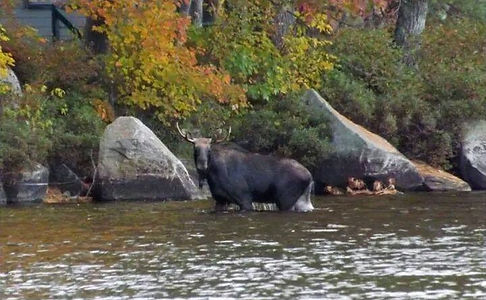MAMMALS
Maine is well known for its wildlife. Our state has one of the biggest moose and black bear populations in the “Lower 48”. Bear and moose, along with white-tailed deer are arguably the most sought after mammals for viewing and hunting. However, smaller mammals such as beaver are also very popular with tourists. Other small mammals, known as furbearers, because they were traditionally caught for their valuable fur, may occasionally be seen by watchful hikers and are still trapped in Maine. Trapping in Maine is a closely regulated activity, and like hunting, is regulated to allow wildlife populations to thrive for future generations to enjoy. Read more...

MOOSE
An icon of the Maine woods, Maine is home to the highest moose population in the lower 48 states. The scientific name for moose is Alces alces americana – origin of the word moose comes from the Algonquin word ‘moosu’ meaning ‘bark stripper.
Moose have been seen strolling in the shallow waters of Keoka. The one to the left was spotted in front of Kokosing. Read more...
BEAVERS
Beavers are the largest living rodents in North America, with adults averaging 40 pounds in weight and measuring more than three feet in length, including the tail. Beavers are the only species that can actually create its own habitat, and it does so by impounding water. In doing so, beavers are considered a keystone species, meaning their presence in nature greatly impacts other wildlife, providing quality wetland habitat for many dozens of other species of wildlife.
Recently, there was a growth in the beaver population on Keoka Lake. They were building dams on Kedar Brook that caused flow problems into the lake. They were also destroying trees around the lake. In 2021 the beavers were removed. Read more...


BATS
The bat population has been in decline in Maine ever since 2011, when the onset of white nose syndrome caused by a harmful fungus began to kill off different bat species here. Bats are beneficial to the ecosystem, particularly because they eat insects and pests. Read more...
